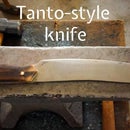Introduction: Bedside Table + Storage Shelves
A Few Years Ago, I made a bedside table. The strength of it was very questionable, It was too small, and it looked pretty ugly (One of the legs actually fell off once!). This is why I decided to make a new one. On this table, I made it bigger, added shelving for extra storage, and made it look nicer.
Supplies
1/2 Inch Plywood
Angle Iron
Wood finish
5 Minute Epoxy
Orbital Sander (optional)
Step 1: Designing
Designing is one of the most important parts of this project. It is important because it is the part where you can visualize what the final product will look like. I like doing this because I often will end up changing the design of a project halfway through it, which will make it turn out weird. I use fusion 360 to design my projects. Some people may say that this step is a waste of time, But everyone has a different opinion.
Step 2: Cutting and Painting the Steel
The steel in this project is used to stiffen the body of the table and cover up the corners of the plywood to make it look nicer. To make the steel look nicer, since it was rusty, I used an orbital sander to remove the rust, then spray painted them black. After the paint had dried, I used a high grit sandpaper to smooth the paint out and get rid of imperfections. If you use low grit sandpaper, it will sand off the paint, and you will need to repaint it.
Another way to make the metal look nice is by using a belt sander to give it a brushed metal look. I didn't do this because metal rusts faster if it isn't polished and doesn't have a protective coating.
Step 3: Measuring and Cutting Plywood
This is another important step of this project. If you get the measurements wrong, you can NOT go back and fix it later.
Here are the measurements of the table pieces:
x2 fifteen by fifteen inch squares
x2 fourteen by fourteen inch squares
x2 four by twenty inch rectangles
x2 five by twenty inch rectangles
To cut these pieces I used a table saw because it is really good for making clean, straight cuts. It is also extremely useful for cutting out squares of wood because you can set the fence to a certain length away from the blade (like 14/15 inches), and not worry about measuring a bunch or not measuring right.
Step 4: Assembly
This is step where you put everything together. The first thing I did to assemble it was glue the plywood corners to the angle iron with 5 minute epoxy. (the plywood corners are the 5 and 4 inch rectangles.) Also remember to clamp it while it is drying so it doesn't fall apart while you are waiting. After the epoxy hardens, measure 7 inches up from the bottom of the corners and make a mark.This is where the first shelf will go. The do this again but mark it at the 14 inch mark. To hold the shelves in place, I used eight 90 degree Simpson strong-ties(four for each shelf), and put them on the 7 and 14 inch marks. After I had those secured, I glued the corners to the base (one of the 15x15 inch squares) and waited for them to dry. Then I attached the shelves using Short screws (4th Picture).
After the shelves where attached, I glued the tabletop on top with 5 minute epoxy. (If you aren't satisfied with how it looks by now, don't worry, there is still another step.)
Step 5: Finish Work
This is the step where you make it look nice. One thing I did to make it look nicer was rounding off the edges with an orbital sander. Another thing I did was cover the edges of the plywood edges with solid wood because I didn't like the way it looked. After the edge pieces where glued on, I saw that they where slightly warped, so I smoothed the uneven edges with the orbital sander until they where even with each other. To protect the wood from getting scratched and dirty, I used a clear wood finish that you spray on (fifth picture). You can also use stain to make the wood darker, and then apply the finish.
If I had to do this project again, I think I would've put the edge wood on all the places where the sides of the plywood are. I also would have the made the edge wood a darker material, so it would contrast better with the light plywood. Thank you for reading, and I hope you enjoyed this instructable!











